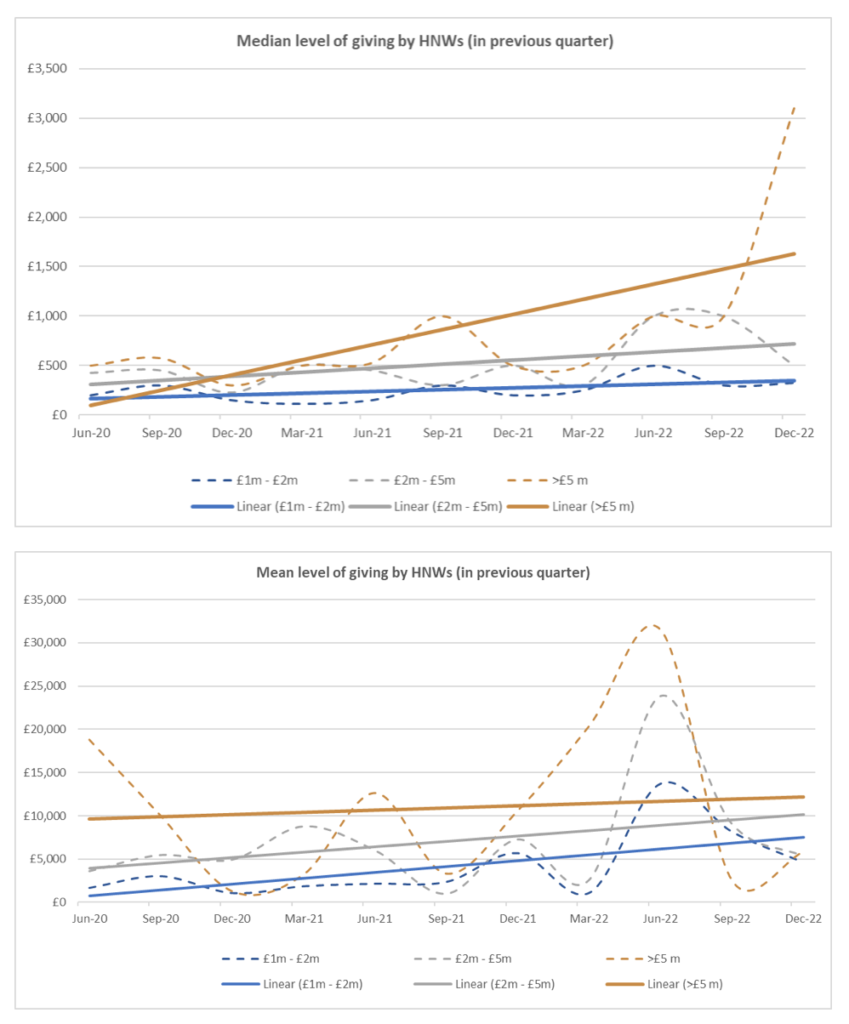
New data shows philanthropy is growing in the UK
I hope you don’t mind if we shout this from the rooftops – yes, we think philanthropy is growing in the UK and here is the reason why.
For over two years, we have been asking wealthy people how much they gave in the previous quarter and our results are showing positive findings.
Since 2020, we have worked with market research agency Savanta to monitor giving among a representative sample of millionaires on a quarterly basis.
The results have identified four valuable trends:
1. Since 2020 more wealthy people are giving more
We know this because the median level of giving is growing.
The median is the point at which half the sample population is above the threshold, and half is below. If the median giving level is going up, more wealthy people are giving more.
2. Giving is growing fastest among those with assets >£5 million
It stands to reason that those with the biggest cushion of assets are able to give most, especially in times of need, which is what we have seen in the last two years.
The median level of giving among those with £5 million in investable assets has more than doubled, on an annualised basis, from £2,500 in 2021 to £5,600 in 2022.
Meaning half of pentamillionaires gave more than £5,600 last year.
3. Generosity among wealthy people is increasing
This is a bold claim, we know.
But we believe it is true because the average level of giving (or mean) is also going up sharply.
Average levels of giving are particularly sensitive to big gifts.
So, if there are a lots of biggish gifts, or if a few people give a huge amount, then the average goes up.
Among those with wealth of £1 million – £5 million the average level of giving doubled from £17,600, on an annualised basis, in 2021 to £34,000 in 2022.
It also doubled among pentamillionaires, leaping from £30,000 to £60,000.
Whether the numbers reflect lots of biggish gifts or a few huge gifts, the underlying trend is of generosity among our most generous.
4. The most generous think hardest about their giving
How did we come to this conclusion from a bunch of numbers on giving levels?
Well, if you look carefully at the quarterly data, you can see there is a spike in the mean level of giving about a cycle before the median.
In other words, the most generous give early and give big.
By cross-referencing with events in the news, we can see surges through the Covid waves, the Ukraine invasion and the cost of living crisis.
So, why are other studies more pessimistic?
Like all questions that involve numbers, the answer depends on what you count.
We measure giving according to the level of investable wealth a person holds. That means, the money they hold in savings and investments, excluding their primary home.
You can only get at these results through highly targeted surveys – population surveys and government sources won’t capture it.
In our research, we only look at those with investable assets over £1 million, which means we are focusing on a very small group within the UK population – about 0.5%.
Other studies tend to track levels of giving according the donor’s level of income. So when they talk about the “top 1%” they mean all those earning more than £160,000 a year.
The distinction between income and assets is important because high earners are not necessarily wealthy.
In fact, they are often cash rich and asset poor, as more expensive lifestyles can mean less money to save.
Conversely, those who are asset-rich often show up in lower income bands because they may work less or they may draw down capital from their investments to support their lifestyles.
So, when recent studies have shown shrinking amounts of giving in the wider population and among high-earners, they have identified that income-earners are feeling the pinch and therefore giving less – an unsurprising finding after a difficult economic decade.
The point here is that income is not a good guide to how rich people feel. It’s assets that count.

Nurturing the green shoots of giving
In a market environment when donating money is going to be hard for most people in the UK, it is more important than ever for civil society to understand the dynamics of giving among the most wealthy.
If philanthropy means helping out when others can’t, then this is a moment when we need wealthy people to find their philanthropic feet.
For fundraisers, we hope these findings help to plan your targeted campaigns.
For wealth managers, it isn’t only your ultra-HNW clients who are giving to support charities through the cost of living crisis.
Your core clients are giving more too. Your support to identify how much they can give and for how long will help them to plan their philanthropy.
For philanthropists, you are not alone.
If you are worried about giving at a time when money is tight, be bold.
Others are giving more too. The charities you care about need your continued support. They may not know you have the capacity to help, so reach out to them. Give your wealth adviser a nudge too. They probably don’t know you give. If they did, maybe they could help you plan a giving strategy so you can worry less about giving more in uncertain times.
Where next?
- Downward dip in major gifts bolstered by wider giving by the wealthy
-
High-net-worth giving continues upward trend to June 2022